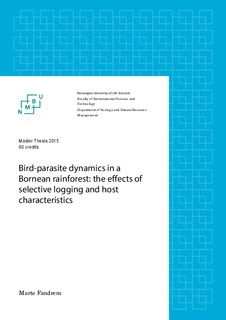| dc.contributor.author | Fandrem, Marte | |
| dc.date.accessioned | 2015-11-05T14:22:37Z | |
| dc.date.available | 2015-11-05T14:22:37Z | |
| dc.date.copyright | 2015 | |
| dc.date.issued | 2015-11-05 | |
| dc.identifier.uri | http://hdl.handle.net/11250/2359471 | |
| dc.description.abstract | Parasites are a natural and integral part of all ecosystems, but human disturbance could potentially negatively affect the host-parasite dynamics. Selective logging is considered one of the major threats to forest biodiversity in Southeast Asia, but how does logging affect avian-parasite dynamics? I investigated avian ectoparasites and blood parasites in primary and logged forest sites in Northeast Borneo, Malaysia, and tested whether parasite infestation intensity or prevalence differed between habitat types, the species- and trait-specific variation of parasite infestation within the avian community, and the connection between avian parasite infestation and avian body condition. There were overall little difference between forest types in intensity and prevalence of avian parasites, and no correlation of avian parasites and the body condition indices. Infection of blood parasites was slightly positively correlated to higher intensity and prevalence of ectoparasites, indicating that initial infection could increase the susceptibility of multiple infections. There were evidential differences within intensity and prevalence between species, families, and trait groups, highlighting the importance of detailed ecological knowledge of the study system to predict the effect of habitat alteration. That only a few significant forest type interactions were found, is likely an effect of the limited sample sizes and highly aggregated distribution of parasites. The changes in intensity and prevalence of avian parasites and the implications for the avian community following logging remain difficult to predict, as host-parasite systems are complex and subject to many uncontrolled variables. However, the results indicate that selectively logged forest and primary forest are very similar with regards to the ecological factors affecting the avian-parasite dynamics of the tropical forests in Borneo. | nb_NO |
| dc.description.abstract | Parasitter er en naturlig og omfattende del av alle økosystemer, men menneskelige forstyrrelser kan potensielt påvirke dynamikken mellom vert og parasitter negativt. Selektiv hogst er ansett som en av de største truslene mot biodiversiteten i Sørøst Asias skoger, men hvordan vil hogst påvirke fugleparasittene? Jeg undersøkte ektoparasitter og blodparasitter hos fugl i primærskog og hogstskog i nordøst-Borneo, Malaysia, og testet om intensitet eller prevalens av parasitter var ulik i disse to habitatene, og om parasitter kunne kobles til kondisjon og ulike økologiske og funksjonelle trekk ved fugler. Det var liten forskjell mellom skogstypene i intensitet og prevalens av fugleparasitter, og ingen korrelasjon mellom fugleparasitter og fuglenes kondisjon. Infeksjon av blodparasitter var svakt positivt korrelert med høyere intensitet og prevalens av ektoparasitter, noe som kan antyde at primærinfeksjoner kan lede til flere infeksjoner. De tydelige forskjellene i intensitet og prevalens av parasitter mellom arter, familier og funksjonelle grupper viser at detaljert økologisk kunnskap om artene og systemet undersøkt er viktig for å kunne avgjøre potensiell effekt av habitatendringer. At bare noen få signifikante forskjeller mellom skogstyper ble funnet er sannsynligvis forårsaket av det begrensede antallet individer målt I hver artsgruppe og de svært aggregerte distribusjonene av parasitter. Endringer i intensitet og prevalens av fugleparasitter og implikasjonene for fuglesamfunnet i sin helhet som følge av hogst forblir vanskelige å forutse, ettersom vert-parasitt systemer er komplekse og avhengige av mange ukontrollerbare variabler, men resultatene indikerer at hogstskog og primærskog i tropiske skoger i Borneo er svært like med tanke på de økologiske faktorene som påvirker dynamikken mellom fugler og deres tilhørende parasitter. | nb_NO |
| dc.language.iso | eng | nb_NO |
| dc.publisher | Norwegian University of Life Sciences, Ås | |
| dc.rights | Navngivelse 3.0 Norge | * |
| dc.rights.uri | http://creativecommons.org/licenses/by/3.0/no/ | * |
| dc.subject | avian | nb_NO |
| dc.subject | parasites | nb_NO |
| dc.subject | logging | nb_NO |
| dc.subject | rainforest | nb_NO |
| dc.subject | Borneo | nb_NO |
| dc.subject | Haemoproteus | nb_NO |
| dc.subject | birds | nb_NO |
| dc.subject | haemoprotozoa | nb_NO |
| dc.subject | feather mites | nb_NO |
| dc.title | Bird-parasite dynamics in a Bornean rainforest : the effects of selective logging and host characteristics | nb_NO |
| dc.type | Master thesis | nb_NO |
| dc.subject.nsi | VDP::Mathematics and natural science: 400::Zoology and botany: 480::Ecology: 488 | nb_NO |
| dc.subject.nsi | VDP::Mathematics and natural science: 400::Zoology and botany: 480::Parasitology: 484 | nb_NO |
| dc.source.pagenumber | 88 | nb_NO |
| dc.description.localcode | M-ECOL | nb_NO |

